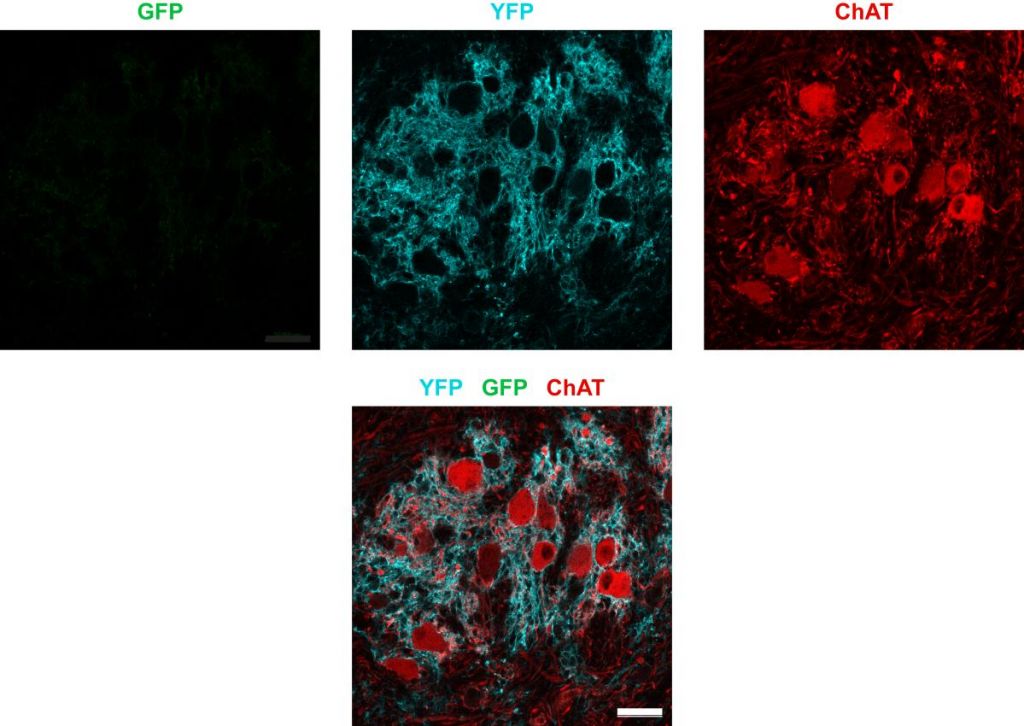博文
光遗传学和神经干细胞联姻
 精选
精选
||
干细胞虽然能实现目标细胞再生,但对神经细胞来说,产生电活动才能发挥功能,这正是神经干细胞移植中面临的困难。光遗传学技术能用光控制神经细胞的电活动。因此可以结合两种技术,将再生的神经细胞用光操纵实现功能。今天《科学》发表来自英国J. Barney Bryson等的研究,正是通过这样的思路解决了神经干细胞领域的这个问题。
光遗传学,是研究人员使用一种新的光控方法选择并打开了某种生物的一类细胞。这也帮助科学家解答一个长期存在的难题,即关于脊髓中某类神经元的特殊功能的研究。光遗传学(optogenetics)——结合遗传工程与光来操作个别神经细胞的活性,发现脑部如何产生γ波(gamma oscillations),并为它们在调控脑部功能中的角色提供新证据,这将有助于发展一系列脑相关失调的新疗法。使用这些光遗传学(optogenetic)工具,能够激活清醒哺乳动物的单一神经元,并直接演示神经元激活表现出的行为结果。该光遗传学方法使得研究人员能够获得关于脊髓回路的一些重要信息。
疾病和创伤都可导致的神经损伤,但身体神经再生十分困难。采用干细胞移植是解决神经再生的可行性手段,但是新生的神经细胞难以和中枢神经系统进行信号交流,则难以解决中枢对外周发出指令的问题。也就是说难以实现大脑对再生神经细胞的控制。为了克服这一困难,通过外界刺激代替中枢发出指令,以实现神经功能的恢复。Bryson等最近研究就是结合光遗传学技术,采用光线控制不同新生运动神经细胞。用小鼠的研究发现,这种手段建立的工程运动神经细胞能,通过光刺激建立受损伤坐骨神经的电信号传递,并能引起支配肌肉的运动。作者认为,这一技术将为将来中枢神经损伤导致的肌肉运动障碍提供了一种解决方案。



Schematic showing ChR2-motorneuron graft-site and engrafted nerves and target muscles. Both tibial and common peroneal nerve branches were engrafted; tibial nerve innervates posterior compartment, lower-hind limb muscles (including Triceps Surae), and common peroneal nerve innervates anterior compartment muscles (including tibialis anterior and extensor digitorum longus, indicated by dashed lines). Time course of ligation, engraftment and analysis shown at lower left.
1. W. W. Glenn, M. L. Phelps, Diaphragm pacing by electrical stimulation of the phrenic nerve. Neurosurgery 17, 974–984 (1985). Medline doi:10.1227/00006123-198512000-00021
2. R. P. Onders, M. Elmo, S. Khansarinia, B. Bowman, J. Yee, J. Road, B. Bass, B. Dunkin, P. E. Ingvarsson, M. Oddsdóttir, Complete worldwide operative experience in laparoscopic diaphragm pacing: Results and differences in spinal cord injured patients and amyotrophic lateral sclerosis patients. Surg. Endosc. 23, 1433–1440 (2009). Medline doi:10.1007/s00464-008-0223-3
3. B. Gernandt, Pain conduction in the phrenic nerve. Acta Physiol. Scand. 12, 255–260 (1946). doi:10.1111/j.1748-1716.1946.tb00385.x
4. S. C. Zhang, Embryonic stem cells for neural replacement therapy: Prospects and challenges. J. Hematother. Stem Cell Res. 12, 625–634 (2003). Medline doi:10.1089/15258160360732650
5. M. T. Filbin, Myelin-associated inhibitors of axonal regeneration in the adult mammalian CNS. Nat. Rev. Neurosci. 4, 703–713 (2003). Medline doi:10.1038/nrn1195
6. J. M. Harper, C. Krishnan, J. S. Darman, D. M. Deshpande, S. Peck, I. Shats, S. Backovic, J. D. Rothstein, D. A. Kerr, Axonal growth of embryonic stem cell-derived motoneurons in vitro and in motoneuron-injured adult rats. Proc. Natl. Acad. Sci. U.S.A. 101, 7123–7128 (2004). Medline doi:10.1073/pnas.0401103101
7. D. C. Yohn, G. B. Miles, V. F. Rafuse, R. M. Brownstone, Transplanted mouse embryonic stem-cell-derived motoneurons form functional motor units and reduce muscle atrophy. J. Neurosci. 28, 12409–12418 (2008). Medline doi:10.1523/JNEUROSCI.1761-08.2008
8. G. Nagel, T. Szellas, W. Huhn, S. Kateriya, N. Adeishvili, P. Berthold, D. Ollig, P. Hegemann, E. Bamberg, Channelrhodopsin-2, a directly light-gated cation-selective membrane channel. Proc. Natl. Acad. Sci. U.S.A. 100, 13940–13945 (2003). Medline doi:10.1073/pnas.1936192100
9. E. S. Boyden, F. Zhang, E. Bamberg, G. Nagel, K. Deisseroth, Millisecond-timescale, genetically targeted optical control of neural activity. Nat. Neurosci. 8, 1263–1268 (2005). Medline doi:10.1038/nn1525
10. M. E. Llewellyn, K. R. Thompson, K. Deisseroth, S. L. Delp, Orderly recruitment of motor units under optical control in vivo. Nat. Med. 16, 1161–1165 (2010). Medline doi:10.1038/nm.2228
11. C. Towne, K. L. Montgomery, S. M. Iyer, K. Deisseroth, S. L. Delp, Optogenetic control of targeted peripheral axons in freely moving animals. PLOS ONE 8, e72691 (2013). Medline doi:10.1371/journal.pone.0072691
12. C. B. Machado, K. C. Kanning, P. Kreis, D. Stevenson, M. Crossley, M. Nowak, M. Iacovino, M. Kyba, D. Chambers, E. Blanc, I. Lieberam, Reconstruction of phrenic neuron identity in embryonic stem cell-derived motor neurons. Development 141, 784–794 (2014). Medline doi:10.1242/dev.097188
https://blog.sciencenet.cn/blog-41174-782031.html
上一篇:研究发现氢水可治疗疼痛
下一篇:硬餐减肥新理论